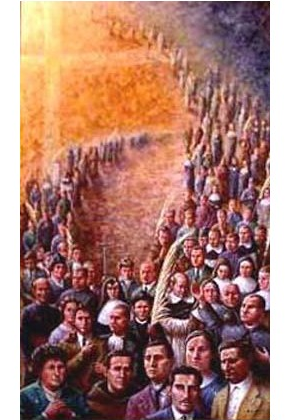Servant of God: SG Joachim Valenti; SJ. SG Louis Boguna, SJ; SG Joseph Verges, SJ
Joachim Valenti, SJ
Born: October 17, 1884
Died: August 14, 1936
SG Louis Boguna, SJ
Born: April 14, 1893
Died: August 14, 1936
SG Joseph Verges, SJ
Born: January 10, 1898
Died: August 14, 1936
 Fr Joachim Valenti was born in Taragona and entered the Society on April 9, 1904 in Saragossa. He studied philosophy at Tortosa from 1910 –1913, taught at the Jesuit school in Sarria for three years after his philosophy and remained there to complete his theology. He was ordained in 1919 and was then assigned to teach Latin at the College of St Joseph in Valencia for eight years before he became the parish priest of the Jesuit church in Verona. At the time of the Society’s suppression in Spain in 1932, Fr Valenti spent three months living with the Bassols family before leaving for Barcelona to carry on his ministry among working people.
Fr Joachim Valenti was born in Taragona and entered the Society on April 9, 1904 in Saragossa. He studied philosophy at Tortosa from 1910 –1913, taught at the Jesuit school in Sarria for three years after his philosophy and remained there to complete his theology. He was ordained in 1919 and was then assigned to teach Latin at the College of St Joseph in Valencia for eight years before he became the parish priest of the Jesuit church in Verona. At the time of the Society’s suppression in Spain in 1932, Fr Valenti spent three months living with the Bassols family before leaving for Barcelona to carry on his ministry among working people.
Fr Louis Boguna was born near Barcelona, at San Andres de Palomar and joined the Jesuits on August 17, 1909, at Gandia. His early studies were done at Gandia and Sargossa and later in 1916 he went to Tortosa to do his philosophy. He taught mathematics and French at the Jesuit school in Saragossa from 1919 to 1923 before doing his theological studies at Sarria from 1923 to 1927. He was ordained in 1926 and after his tertianship he was assigned to the Sacred Heart College in Barcelona and there, among other things, he directed the sodality at the Torras y Bages Academy.
Fr Joseph Verges, the youngest of the three Jesuits martyred in Gerona, was born in Barcelona. He entered the Society at Gandia and after completing humanistic studies at Saragossa, he taught for three years at the College of St Dominic in Orihuela before pursuing from 1924 to 1931, his philosophy and theology studies at Sarria. He was ordained in 1930. Shortly after he had completed his Jesuit formation, the Society was suppressed in Spain and thus he moved to Gerona to carry out his ministry in secret.
Frs Boguna and Verges were fortunate enough to be able to celebrate Mass everyday while they were staying at the Bassols residence. They were also able to distribute Communion daily to the faithful in the city who were now unable to attend Mass with the destruction of the city’s churches. The two Jesuits who found out where the religious sisters, whose convents had been burned, were staying, visited them to encourage them. They also kept in touch with other Jesuits hiding in the city. However their frequent visits were soon discovered and before they could change their residence, the Jesuits at the Bassols residence were betrayed by a guard on duty at the city’s tax building who concluded that Fr Buguna’s frequent trips to the head of the tax office, a fervent Catholic must be to bring him Communion, and must be a priest.
Together with Frs Boguna, Verges and Valenti was a diocesan priest, Fr John Guix in the Bassol residence. During the week of July 13, 1936, thousands of sodalists from the diocese of Gerona gathered at our Lady’s sanctuary to participate in a convention. Fr Verges was the moderator of the largest sodality while Fr Boguna, a director of a sodality came on July 16 to attend the final meeting. Fr Valenti’s purpose for coming to Gerona on August 11 was to secure a working permit from the trade union office as this would allow him to mingle freely with the workers and to continue with his ministry unnoticed. He had made his way to the Bassols residence at 10.00 pm on the evening of August 13.
On the evening of August 13, the four priests had their evening meal with Mrs Bassols and her two sisters and had retired for the night when armed militiamen surrounded the Bassols residence at 11.00 pm. The group leader and a few soldiers and the guard from the tax office building knocked loudly at the door and continued to knock persistently although they were told by a neighbour that it was useless to do so as the three old ladies were unable to hear the knocking. When Mrs Bassols finally opened the door, he assured the leader that there were no soldiers in the house. When the leader saw a hat on the rack and asked: “To whom does that man’s hat belong to?” he was again told that there were no soldiers in the house. Meantime Frs Verges and Valenti came down the stairs and behind them were Frs Guix and Boguna. While the priests were being searched, the entire house and garden were also thoroughly searched. After three hours the priests were taken away. Just before they left, Fr Valenti turned to Mrs Bassols and said: “If we do not see each other again here, then in heaven.”
The four priests were driven a short distance outside Gerona. At the crossroads leading to Can Veray, they were shot by machine gun fire when their backs were turned. Two of them fell at the side of the road and the other two next to the railroad tracks. It was 2.30 am on the 15 th of August 1936. They were buried in the cemetery at Celra on the same day but their remains were recovered in 1939 and taken to Gerona. The diocesan investigation into the martyrdom of Frs Valenti, Boguna, Verges and the diocesan priest, Fr Guix commenced on September 26, 1951
